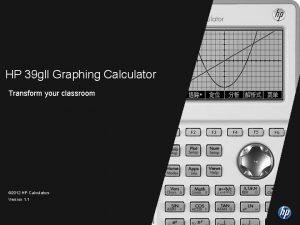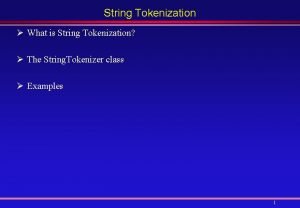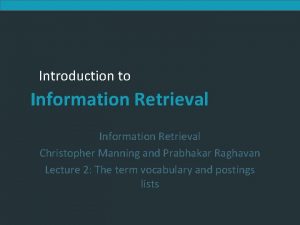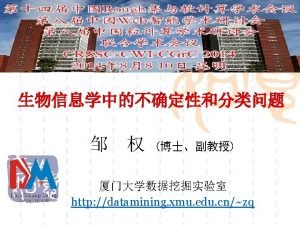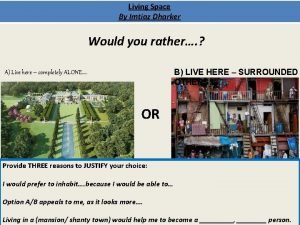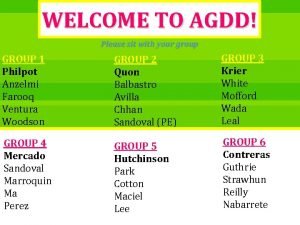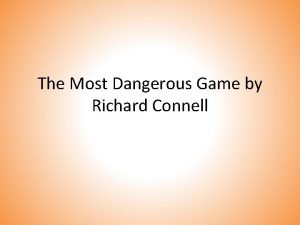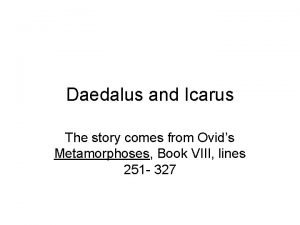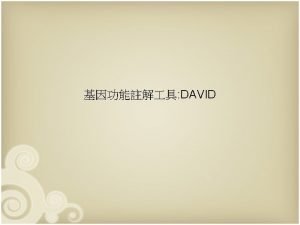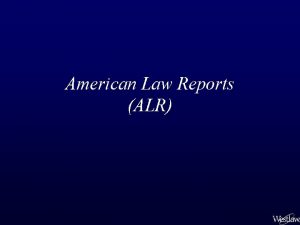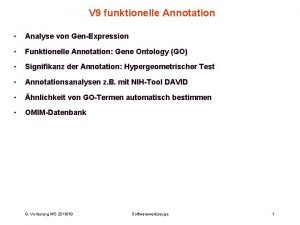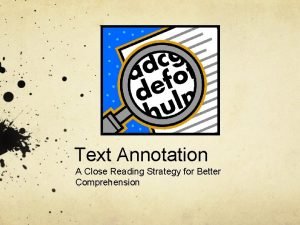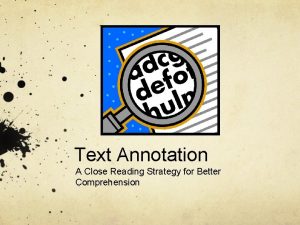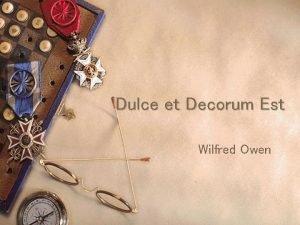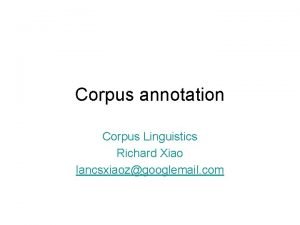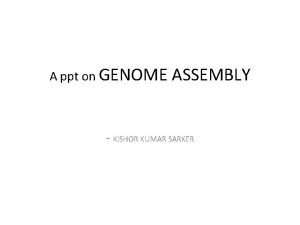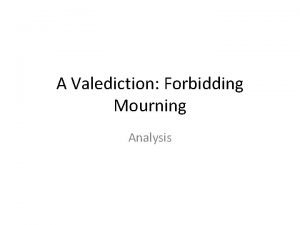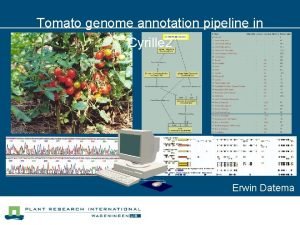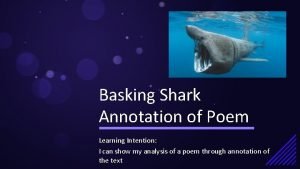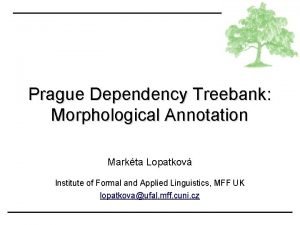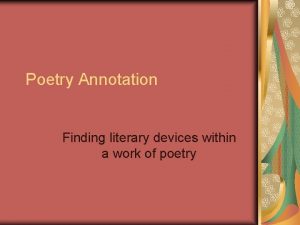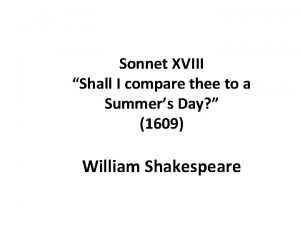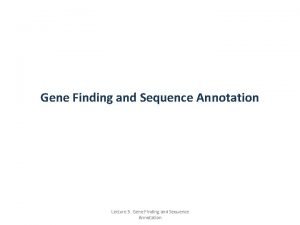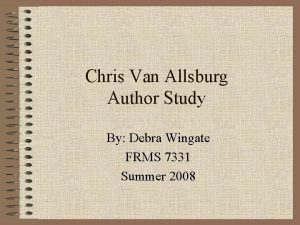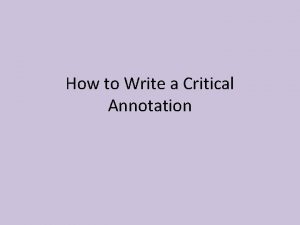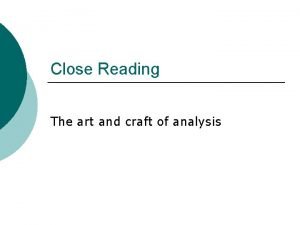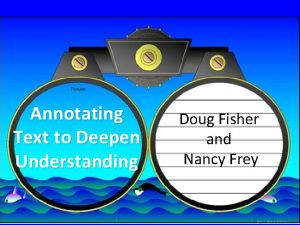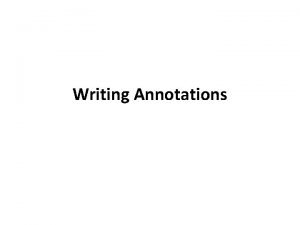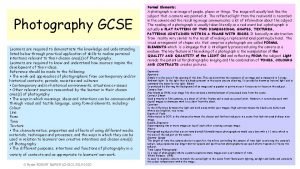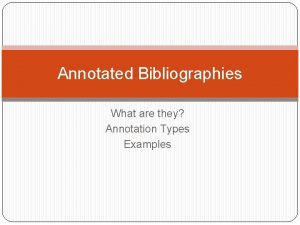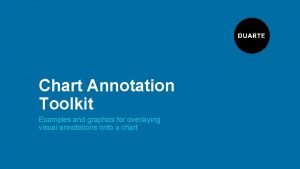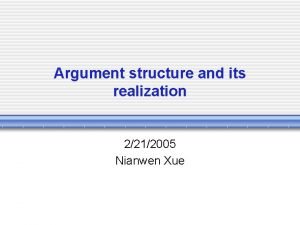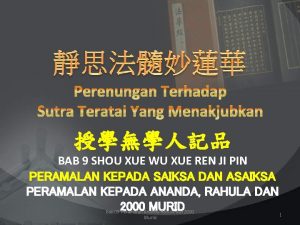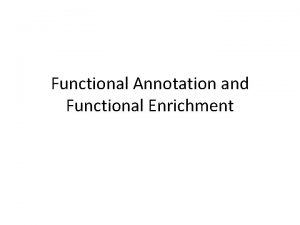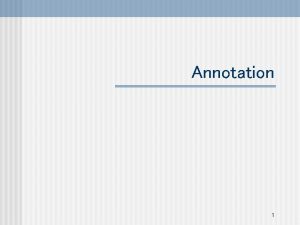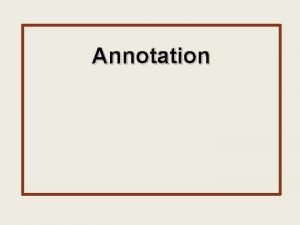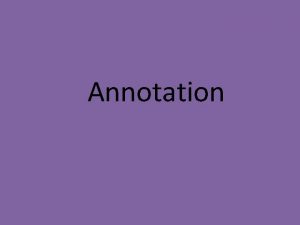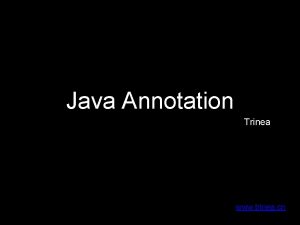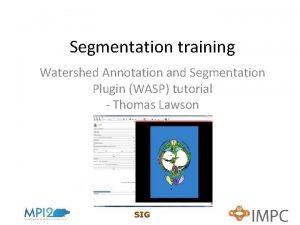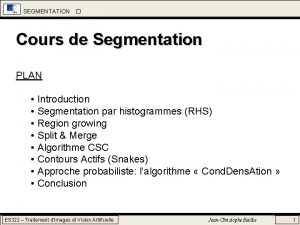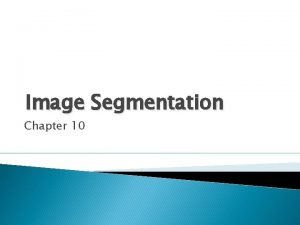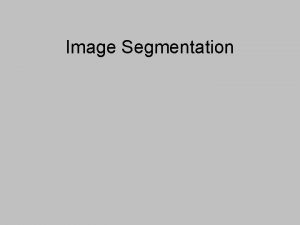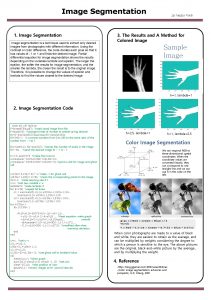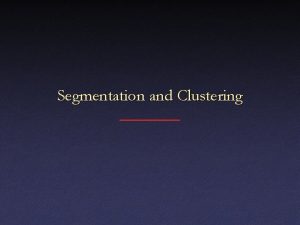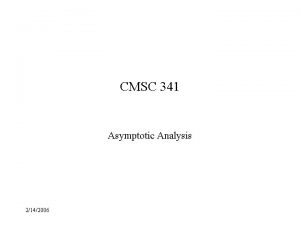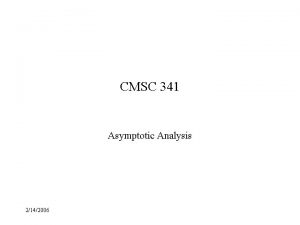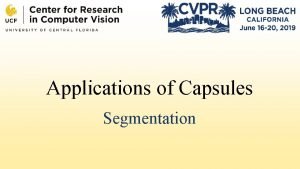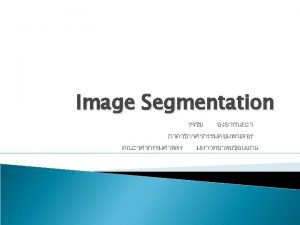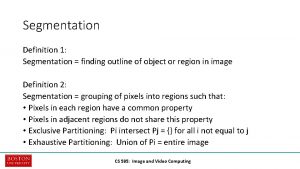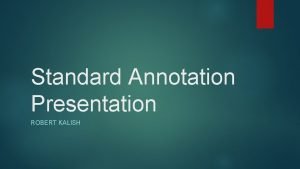Linguistic annotation 2142006 Nianwen Xue Outline Tokenization segmentation
























































- Slides: 56

Linguistic annotation 2/14/2006 Nianwen Xue

Outline • Tokenization / segmentation, POS tagging • Treebanking w Constituent structure and structural ambiguity w Basic grammatical relations and how argument structure is instantiated • Propbanking/nombanking w Cross-linguistic syntactic alternations, verb senses and argument structure • Others: named entity, coreference, discourse connectives 2

Tokenization • English w In the new position he will oversee Mazda ’s U. S. sales , services , parts and marketing operations. w We did n’t have much of a choice. w U. S. trade officials said the Philippines and Thailand would be the main beneficiaries of the president ‘s action. w Anything ‘s possible -- how about the new Guinea Fund ? 3

Tokenization • English w In the new position he will oversee Mazda ’s U. S. sales , services , parts and marketing operations. w We did n’t have much of a choice. w U. S. trade officials said the Philippines and Thailand would be the main beneficiaries of the president ‘s action. w Anything ‘s possible -- how about the new Guinea Fund ? 4

Tokenization • The federal government suspended sales of the U. S. savings bonds because Congress has n’t lifted the ceiling on government debt. • The Treasury said the U. S. will default on Nov. 9 if Congress does n’t act by then. 5

Tokenization • The federal government suspended sales of the U. S. savings bonds because Congress has n’t lifted the ceiling on government debt. • The Treasury said the U. S. will default on Nov. 9 if Congress does n’t act by then. 6

Tokenization • Assets of the 400 taxable funds grew by $ 1. 5 billion during the latest week. • Exports in October stood $ 5. 29 billion , a mere 0. 7 % increase from a year earlier , while imports increased sharply to $ 5. 39 billion , up 20 % from last year. • Do you notice any ambiguity in tokenization? 7

Tokenization • Assets of the 400 taxable funds grew by $ 1. 5 billion during the latest week. • Exports in October stood $ 5. 29 billion , a mere 0. 7 % increase from a year earlier , while imports increased sharply to $ 5. 39 billion , up 20 % from last year. • Do you notice any ambiguity in tokenization ? 8

Exercise • How many sentences in the WSJ corpus of the Penn Treebank contain “’re”? • How many sentences in the WSJ corpus of the Penn Treebank contain “’d”? 9

Big deal, you say • The problem is pushed to the forefront for languages like Chinese, where there are no delimiting spaces between words �句�里有几个� ? Howmanywordsarethereinthissentence? 10

Big deal, you say • The problem is pushed to the forefront for languages like Chinese, where there are no delimiting spaces between words zhe ju hua li you ji ge ci � 句 � 里 有 几 个 � ? this CL sentence inside have [how many] CL word ? How many words are there in this sentence ? 11

A much harder problem than it first appears… • Well, what if we just create a list of words (a dictionary) and compare the sentence against this list? • 日文章�怎么� ? Dictionary entries: 日 “Sun”, 日文 “Japanese”, ,文章 “article”, ,章� “octopus”, � “fish” 怎么 “how” � “say” 12

A much harder problem than it first appears… • Well, what if we just create a list of words (a dictionary) and compare the sentence against this list? • 日文 章� 怎么 � ? Japanese Octopus how say How do you say octopus in Japanese? • 日 文章 � 怎么 � ? Sun article fish how say ? ? ? 13

Computer problem vs human problem • Well that may be a problem for the computer because the computer is dumb… • Segmentation is difficult for humans as well w What is a word? w Different criteria do not coincide 14

What if we let native speakers follow their intuitions? • Inadequate level of inter-annotator agreement w Sproat, 1996: 70% w Xue at al, 2005: 90% • Conclusion: need a linguistic definition of wordhood to develop segmentation standards 15

Packard’s (2000) notion of words • Orthographic word: Words are defined by delimiters in written text. This appears to have no relevance in Chinese since there are no such written delimiters • Sociological word: Following (Chao, 1968, pp. 136138), these are ‘that type of unit, intermediate in size between a phoneme and a sentence, which the general, non-linguistic public is conscious of, talks about, has an every day term for, and is practically concerned with in various ways. ’ In English this is the lay notion of ‘word’, whereas in Chinese this is the character (字zi). 16

Packard’s notions of word • Lexical word: This corresponds to Di Sciullo and Williams’s (1987) listeme • Semantic word: Roughly speaking this corresponds to a “unitary concept”. • Phonological word: defined according to phonological criteria. Is it a domain that a phonological process applies? Is it s prosodic unit? 17

Packard’s notions of word • Morphological word: following Di Sciullo and Williams (1987), a morphological word is anything that is the output of a phonological rule • Syntactic word: These are all and only the constructions that occupy X 0 in the syntax. Well first you need to know what X 0 is. • Psycholinguistic word: this the “ ‘word’ level of linguistic analysis that is … salient and highly relevant to the operation of the language processor” 18

Wordhood tests • Phonological: w Bound morpheme: a bound morpheme forms a word with its neighboring morpheme • Syntactic: w Insertion: if another morpheme can be inserted between X and Y, then it is unlikely a word. w XP-substitution: if a morpheme cannot be replaced with an XP of the same type, then it is likely to be a word 19

Wordhood tests • Semantic w If the meaning of X-Y is non-compositional, then it is a word • Others w Productivity: if a rule that combines morpheme X and morpheme Y is not productive, then X-Y is likely to be a word w Frequency of co-ocurrence: if morphemes X and Y cooccur frequently then they form a word 20

Exercise • Given the wordhood criteria and wordhood tests we have discussed, how many words are there in the “can’t” ? 21

Answer • • Orthographical word: 1 Sociological word: ? Lexical word: 2 Semantic word: 2 Phonological word: 1 Morphological word: 2 Syntactic word: 2 Psycholinguistic word: ? 22

Chinese morphological types • • • Reduplication Affixation Compounding Proper names Abbreviations 23

Verbal reduplication �� shuo-shuo speak-speak little” 看看 kan-kan look-look a look” 走走 zou-zou walk-walk a walk” 磨磨 mo-mo rub-rub little” ���� taolun-taolun discuss-discuss a little” �教�教 qingjiao-qingjiao ask-ask little” “speak a “take “rub a “discuss “ask a 24

Verbal reduplication �一� shuo-shuo a little” 看一看 kan-kan “take a look” 走一走 zou-zou “take a walk” 磨一磨 mo-mo a little” *��一�� *�教一�教 speak one speak “speak look one look walk one walk rub one rub “rub taolun-yi-taolun discuss-one-discuss qingjiao-yi-qingjiao ask-one-ask 25

Adjectival reduplication 舒服 shufu 舒舒服服 shushu-fufu “comfortable” 舒服舒服 shufu-shu-fu “enjoy” 干� ganjing 干干�� gangan-jing “very clean” 干�干� ganjing-ganjing “clean up” 糊涂 hutu 糊糊涂涂 huhu-tutu “muddleheaded” (? ) 糊涂糊涂 hutu-hutu 快活 快快活活 kuai-huohuo “happy” 快活快活 kuaihuo-kuaihuo “make happy” 漂亮 漂漂亮亮 piao-liang“pretty” 26

Prefixation 老 laowang” 小 xiaowang” 第 di“first” 初 chuthird” 可 ke- 老王 小王 第一 初三 可� lao-wang “old xiao-wang “small di yi chu san ke-ai “the “cute” 27

Suffixation 学 -xue 心理学 xinli-xue “psychology” 家 -jia 心理学家 xinli-xue-jia “psychologist” 化 -hua �化 lv-hua “greenize? ? ” 率 -lv �取率 luqu-lv “enrollment rate” 主� -zhuyi �克思主� makesi-zhuyi“marxism” 28

Compounding Location: 客� 沙� keting-shafa “living room sofa” 河 � hema “river horse (hippopotamus)” 海 � haishi “sea lion (seal)” Used for: 指甲 油 zhijia you “nail polish” �� 球 pingpang qiu “ping-pang ball” 太阳眼� taiyang yanjing “sunglasses” Material: 大理石 地板 talishi diban “marble floor” �老 虎 zhilaohu “paper tiger” 29

Resultative verb compounding Result: 打破 dapo “break by hitting” 拉开 lakai “open by pulling” Achievement: 写清楚 xieqingchu “write clearly” �到 maidao “succeed in buying” Direction: 跳�去 tiaoguoqu “jump across” 走�来 zoujinlai “come walking in” 30

Subject-Verb compounds �疼 tou-teng (head hurt) “have a headache” 嘴硬 zui-ying (mouth hard) “stubborn” 眼� yan-hong (eye red) “covet” 心酸 xin-suan (heart sour) “feel sad” 命苦 ming-ku (fate bitter) “unlucky” 31

Subject-Verb compounds 我 的 � 很 疼 I DE head very hurt “My head hurts badly. ” � 事 � 我 很 �疼 This matter make I very headache “This gave me a real headache”. 32

Verb-object compounds 出版 chu-ban (emit edition) “publish” 睡� shui-jiao (sleep) “sleep” �� bi-ye (finish study) “graduate” 开刀 kai-dao (operate knife) “operate” 开玩笑 kai-wanxiao (make joke) “make a joke” 照相 zhao-xiang (shine image) “take a picture” 33

Verb-object compounds � 开玩笑 ! Do not joke! 开 他 的 玩笑。 Make he DE joke Make fun of him. 34

Let’s try one 她 很 担心 孩子 的 健康 成� Test type phonological syntactic semantic others Test Bound morpheme Test result Yes? Prediction One word Syllable count insertion yes no One word XP substitution Non-compositional productive frequency no yes N/A One word N/A 35

But … • 担心: 她 � 孩子 担 心 Test type Test result Prediction Bound morphemes? no Two words Syllable count yes One word Insertion yes Two words XP substitution yes Two words Semantic Non-compositional? yes One word Others Productive? N/A Frequent co-occurrence? N/A phonological syntactic Test 36

Summary • Wordhood has to be decided in context • When wordhood tests lead to conflict predictions, decisions will have to be made based on what the annotated corpus is for. 37

Discussion question • Based on word criteria we have discussed, is “make headway” one word or two words? 38

POS-tagging: throwing words into different buckets… • Each category is a bucket • How many buckets are there? w Noun w Verb w Adjective w Preposition w Adverb • Which bucket should“five”, “the”, “$”, should go? 39

Penn Treebank Tagsets (buckets) • • • CC - coordinating conjunction: and, but CD - cardinal number: one, two, three DT - determiner: a, the, this, that EX - existential there FW - foreign word IN - preposition or subordinate conjunction LS - list marker: firstly, secondly To - to UH - interjection, uh, oh 40

CC or DT • Neither/? ? he or/CC she likes skiing. • Neither/? ? men like skiing. • Either/? ? Jean or/CC Mary likes singing. • Either/? ? Girl likes singing. • Both/? ? Jack and/CC Tom hates singing. • Both/? ? men hates singing. 41

CC or DT • Neither/CC he or/CC she likes skiing. • Neither/DT men like skiing. • Either/CC Jean or/CC Mary likes singing. • Either/DT Girl likes singing. • Both/CC Jack and/CC Tom hates singing. • Both/DT men hates singing. 42

CD or NN • One/? ? of the best reasons • The only one/? ? Of its kind • The only ones/? ? of its kind 43

CD or NN • One/CD of the best reasons • The only one/NN Of its kind • The only ones/NN of its kind 44

EX or RB • • There/? ? was a party in progress. There/? ? ensued a melee. There/? ? , a party was in progress. There/? ? , ensued a melee. 45

EX or RB • • There/EX was a party in progress. There/EX ensued a melee. There/RB , a party was in progress. There/RB , ensued a melee. 46

The role of context in POS tagging • Can we take a list of all the words in a language, and decide which bucket each word should go, without looking at the context in which the word occurs? • Water, can, drops 47

Categorizing context • Morphological • Syntactic • Semantic 48

Morphological context • Inflectional morphology Verb: destroy, destroying, destroyed Noun: destruction, destructions He watered the plant. • Derivational morphology Noun: destruction 49

Syntactic context • Verb: The bomb destroyed the building. He decided to water the plant. • Noun: The destruction of building 50

Semantic context • Verb: action, activity • Noun: state, object, etc. 51

What do we have in Chinese? • Morphological clues: not as much • Syntactic clues: not as rich, but exist • Semantic clues: About the same 52

Syntactic clues • Impoverished, but exist: � 座 大楼 的 倒塌 this CL building DE collapse “the collapse of this building” � 座 大楼 看起来要 倒塌 This CL building seem will collapse “It looks like this building will collapse. ” 53

Semantic clues • Same as English: w Noun: state, object, etc. w Verb: action, activity, etc. 54

When syntactic and semantic clues are in conflict � 座 大楼 的 倒塌 this CL building DE collapse “the collapse of this building” Option 1: 倒塌 is a verb regardless of its context Option 2: 倒塌 can be a noun or a verb depending on its context The Chinese Treebank decision: option 2 w POS tags based on syntactic clues encode not only its own lexical properties, but also information provided by its context w “context-free” POS tags are no better than a dictionary 55

Online references • Chinese Treebank: www. cis. upenn. edu/~chinese • Sproat, Richard. 2002. Coling tutorial: www. linguistics. uiuc. edu/rws • Penn Treebank: www. cis. upenn. edu/~treebank/home. html 56
 What is tokenization
What is tokenization Tokenization
Tokenization Tokenization in information retrieval
Tokenization in information retrieval Xue le moexuele
Xue le moexuele Catalysis lecture notes
Catalysis lecture notes Moe xue le
Moe xue le Harvard catalyst biostatistics
Harvard catalyst biostatistics Polytomous
Polytomous Yao tong xue
Yao tong xue Chenghai xue
Chenghai xue Jilong xue
Jilong xue Sandwich quotes examples
Sandwich quotes examples Living space by imtiaz dharker analysis
Living space by imtiaz dharker analysis Types of holes
Types of holes Macbeth o valiant cousin worthy gentleman
Macbeth o valiant cousin worthy gentleman Catch annotations
Catch annotations General zaroff first comes to the island after
General zaroff first comes to the island after Ovid metamorphoses icarus
Ovid metamorphoses icarus David gene functional classification tool
David gene functional classification tool American law reports annotation
American law reports annotation Theme of acquainted with the night
Theme of acquainted with the night David go annotation
David go annotation Basking shark poem analysis
Basking shark poem analysis Close reading symbols
Close reading symbols What is text annotation
What is text annotation Maplex label engine
Maplex label engine Dulce et decorum est annotation
Dulce et decorum est annotation Acquainted with the night annotation
Acquainted with the night annotation O captain my captain metaphors
O captain my captain metaphors Maxims of annotation in corpus linguistics
Maxims of annotation in corpus linguistics Annotation slows down the reader to deepen understanding
Annotation slows down the reader to deepen understanding De novo genome assembly ppt
De novo genome assembly ppt A valediction forbidding mourning critical analysis
A valediction forbidding mourning critical analysis Tomato genome annotation
Tomato genome annotation The basking shark poem
The basking shark poem Morphological annotation
Morphological annotation Annotating a poem examples
Annotating a poem examples The two terms of comparison in the first two quatrains are
The two terms of comparison in the first two quatrains are Gene annotation
Gene annotation Annotation guide
Annotation guide Jumanji
Jumanji Critical annotation
Critical annotation Close reading the art and craft of analysis
Close reading the art and craft of analysis Annotation slows down the reader to deepen understanding
Annotation slows down the reader to deepen understanding Amazon data annotation
Amazon data annotation What is anotation
What is anotation Maker annotation tutorial
Maker annotation tutorial Nbis
Nbis Benjamin banneker letter to thomas jefferson annotation
Benjamin banneker letter to thomas jefferson annotation Eclipse annotation processor
Eclipse annotation processor Gcse photography annotation
Gcse photography annotation Amazon data annotation
Amazon data annotation Yesterday by patricia pogson analysis
Yesterday by patricia pogson analysis Bacteriophage annotation
Bacteriophage annotation Annotation examples
Annotation examples Ocr gcse art assessment objectives
Ocr gcse art assessment objectives Annotation toolkit
Annotation toolkit
